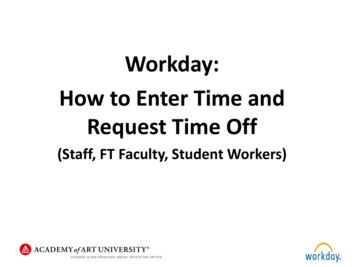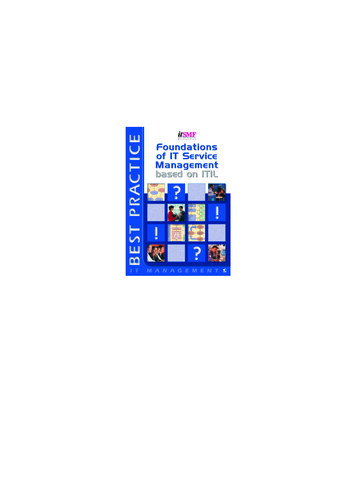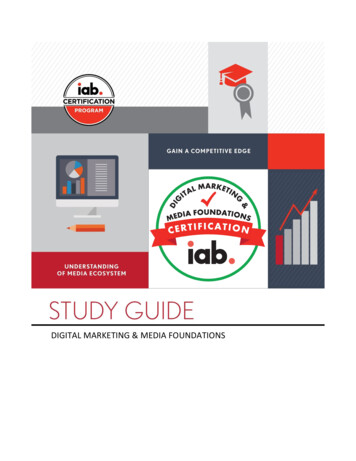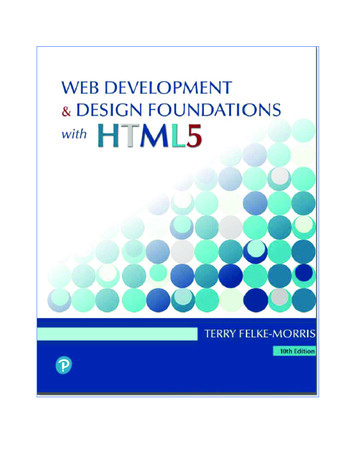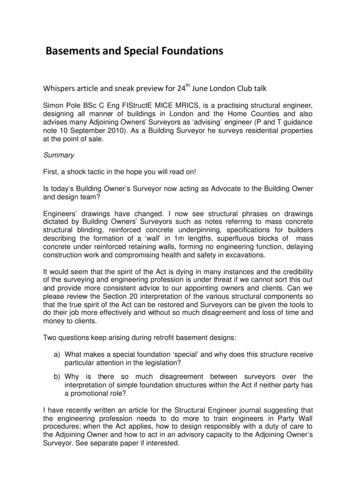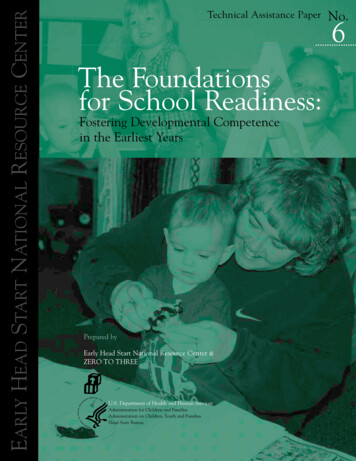
Transcription
EARLY HEAD START NATIONAL RESOURCE CENTERTechnical Assistance PaperNo.6The Foundationsfor School Readiness:Fostering Developmental Competencein the Earliest YearsPrepared byEarly Head Start National Resource Center @ZERO TO THREEU.S. Department of Health and Human ServicesAdministration for Children and FamiliesAdministration on Children, Youth and FamiliesHead Start Bureau
EARLY HEAD START NATIONAL RESOURCE CENTERTA Paper No. 6The Foundations forSchool Readiness:Fostering Developmental Competence in theEarliest YearsThis document was developed by the staff of the Early Head StartNational Resource Center @ ZERO TO THREE in collaboration withthe Head Start Bureau. The contents of the paper are not intended tobe an interpretation of policy.Early Head Start National Resource Center @ ZERO TO THREE2000 M Street, NW, Suite 200Washington, DC 20036-3307Phone: 202-638-1144Fax: 202-638-0851Web site: www.ehsnrc.orgTN CAREs, Early Head Start, Weakley Co, TNThe EHS NRC is funded by contract #105-98-2055U. S. Department of Health and Human ServicesAdministration for Children and FamiliesAdministration on Children, Youth, and FamiliesHead Start BureauOn the CoverCESA #11 Early Head Start, Turtle Lake, WI
Technical Assistance PaperThe Foundations forSchool Readiness:No.6Fostering Developmental Competence in the Earliest YearsEarly childhood programs recognize theIn this paper, we explore the scientific knowledge baseimportance of preparing children for success inconcerning the remarkable developmental tasks thatschool and later in life. Head Start has long beenoccur in the first 5 years of life. We identify thea leader in this effort and in defining the goal of socialcapacities that equip children with the skills they needcompetence. Considering recent media attention on theto negotiate the relationships, responsibilities, andimportance of the early years of life, policymakers,challenges they will face throughout their lives. Weresearchers, parents, and child advocates have anillustrate how early childhood programs, beginning withincreased interest in what it takes to fully preparesupport to expectant families during the prenatal periodchildren to succeed in school. In addition, the risingand through the first 5 years of life, can play a pivotalnumber of working parents has increased the demand forrole in this process. Indeed, comprehensive earlyhigh-quality child care for very young children.childhood programs such as Head Start and Early HeadComprehensive early childhood services such as MigrantStart have the potential to dramatically influence theand Seasonal Head Start and Early Head Start arefuture of children most vulnerable to school failure. Inavailable to children from birth, raising new questionsthis paper, we explore school readiness to illustrate howabout what school readiness means for programs servingearly development influences later learning. However,infants, toddlers, and expectant families.the characteristics we hope to inspire in the childrenwith whom we work are ones that not only equip themNew research has revealed that the social andfor success in school but also prepare them to becomeemotional development of young children and, morecompetent, resilient, effective human beings in all areasspecifically, the nature of early relationships plays aof their lives.critical role in fostering cognitive development. Both theparent-child relationship and the relationships thatchildren develop with other significant caregivers, forexample, in child care settings have an effect on childdevelopment (National Research Council & Institute ofMedicine, 2000). In fact, the emotional and socialcharacteristics are what provide children with the skillsto learn and the motivation to want to learn (ZERO TOTHREE, 1992).Children’s Home Society of Washington, Auburn, WApage1
E A R LY H E A D S T A R T N AT I O N A L R E S O U R C E C E N T E RW HAT D OES S CHOOL R EADINESS M EANP ROGRAMS S ERVING I NFANTS ANDT ODDLERS ?FORsynthesize what is known about early childhooddevelopment and draw conclusions for policymakers,practitioners, researchers, and others invested in thehealthy growth and development of children.From Neurons to Neighborhoods: The Science ofThe authors of the report (National Research CouncilEarly Childhood Development& Institute of Medicine, 2000) emphasize three criticalhe National Research Council and Institute ofTdevelopmental tasks that characterize the importance ofMedicine convened a committee of nationalthe first 5 years of lifeexperts to evaluate and integrate the science of earlySelf regulation is the processchildhood development. The result of this effort is1. Acquiring self-regulation —published in the report From Neurons to Neighborhoods:of “negotiating the transition from external to self-The Science of Early Childhood Development (Nationalregulation, including learning to regulate one’s emotions,Research Council & Institute of Medicine, 2000). Thebehaviors and attention. This captures the emergence ofinformation in this 550-page document analyzes theself-control and independence and can provide anmost current research on brain development and theanalogy for the movement toward competentlatest findings from the social sciences. The authorsfunctioning that characterizes development as a whole”(p. 92).Consider the remarkable transformation thatoccurs in all areas of development during the first 5years of life. A newborn is completely dependent onhis or her caregivers to meet every physical andemotional need. Over time and in the context ofsupportive relationships, young children becomeincreasingly competent in all areas of development.Typical preschoolers have developed many of theskills for feeding, bathing, and dressing themselves;have some understanding of societal and familialnorms, values, and morals; and can share their ownunique opinions, preferences, and interests.2. Communicating and learning —Communicationand learning refers to “acquiring the capabilitiesthat undergird communication and learning. Thisincludes the early development of language,reasoning, and problem solving”(p. 92).The ability to communicate effectively begins inthe earliest moments of life as newborns experiencehaving their needs met through the sensitiveresponse of attentive caregivers. Parents learnThe Ounce of Prevention Fund,Chicago, IL
T E C H N I C A L A S S I S TA N C E PA P E R N O . 6Heart Start: The Emotional Foundations forSchool ReadinessBefore the publication of From Neurons to Neighborhoods,ZERO TO THREE: National Center for Infants, Toddlers,and Families published a series of monographs thatsimilarly pointed to the social and emotional developmentof infants and toddlers as the precursors to success inschool. The authors identified seven characteristics ofchildren who are best prepared to thrive in the schoolenvironment (ZERO TO THREE, 1992):1. Confidence —A sense of control and mastery of one’sbody, behavior, and world; the child’s sense that he orshe is more likely than not to succeed at what he or sheundertakes and that adults will be helpful.In CAREs Early Head Start, Weakley, CO2. Curiosity —The sense that finding out about things ispositive and leads to pleasure.through experience and with support how to successfullyread their child’s cues and begin the back-and-forth“dance” of communication that sets the stage forlanguage and learning. This process evolves in thepreschool years into increasingly sophisticated skills suchpage3. Intentionality —The wish and capacity to have aneffect and to act on that desire with persistence, acharacteristic that is clearly related to a sense ofcompetence and of being effective.as the emerging ability to reason, think logically, andproblem solve.4. Self-Control —The ability to modulate and controlone’s own actions in age-appropriate ways; a sense of3. Getting along with peers —Developing positive peerinner control.relationships involves “learning to relate well to otherchildren and forming friendships. This highlights theemerging capacity to trust, to love and nurture, and toresolve conflict constructively” (p. 92).5. Relatedness —The ability to engage with others basedon the sense of being understood by others andunderstanding others.Later in this paper, we illustrate how relationships arethe vehicle through which learning takes place. Clearly,the parent-child relationship is a child’s first opportunityto experience trust, love, and nurture, and thisrelationship forms the basis for learning to relate well toothers. Thus, programs that serve infants, toddlers, and6. Capacity to Communicate —The wish and ability toexchange ideas, feelings, and concepts with others, acharacteristic that is related to a sense of trust in othersand a sense of pleasure in engaging with others,including adults.their families focus on strengthening parent-childrelationships throughout program activities and services.7. Cooperativeness —The ability in a group activity tobalance one’s own needs with those of others.3
E A R LY H E A D S T A R T N AT I O N A L R E S O U R C E C E N T E RCharacteristics such as these enable children toeffectively support the three developmental tasksrespond to direction, pay attention, communicatediscussed above—acquiring self-regulation,effectively with peers and adults, cope with stress, andcommunicating and learning, and getting along withfeel motivated to learn. Children who are lacking thesepeers—they need to understand both child developmentqualities face much greater challenges and typicallyand the critical link between social and emotionalexperience both behavioral and academic problems.development and early learning.These children are at a greater risk to disrupt theIn the section that follows, we identify four keyclassroom environment, become ostracized by theirconcepts that describe the link between social andpeers, fall behind in academic skills, and eventuallyemotional development and early learning, and weexperience greater behavioral and learning problems thatexplore how parents and significant caregivers helplead to academic failure and school drop-out (Peth-infants and toddlers regulate their emotions andPierce, 2000).behavior, communicate and learn, and develop healthySupport is strong for the idea that school readiness isrelationships with others. These four concepts follow:best considered in the context of fostering children’soverall developmental competence so they can managethe demands and responsibilities of school and life.Developmental competence refers to optimal functioningin all areas of development and is expressed as curiosityand the motivation to learn; the resilience to cope withpage4stress; and the ability to solve problems, communicate Cognitive and social-emotional development areinterrelated. Relationships facilitate learning. Curriculum is delivered through relationships. Staff members can best support children by supportingparents.effectively, and develop close, satisfying relationshipswith peers and adults. This developmental competence isCognitive and Social-Emotional Development Arethe result of positive, nurturing early experiences withInterrelatedsensitive, responsive caregivers and is equally importantFor all children, but especially those in the earliest yearsto the acquisition of specific academic skills. Theseof life, each area of development—physical, cognitive,nurturing experiences are what teach children to managesocial, and emotional—is related to and influences theone’s emotions and behavior, effectively communicateothers. For example, a 6-month-old baby will express hisand learn, and sustain positive relationships with othersdelight with a smile and a full body wriggle. During(National Research Council & Institutes of Medicine,infancy and toddlerhood, it is impossible to separate one2000).developmental domain from any other. In fact, becauseof the infant’s complete dependency on his or herF ROM R ESEARCHFOR P ROGRAMSTOP RACTICE : I MPLICATIONSTcaregivers, all areas of infant development unfold withinthe context of the child’s relationships with others.he experiences of children and families in yourThrough these most important relationships, a childprogram influence how they will approachdevelops not only his or her self-concept but also theexperiences later in life. Comprehensive birth-to-fiveprograms offer a tremendous opportunity to foster thecompetence necessary not only for school success butalso in all areas of development. For staff members to
T E C H N I C A L A S S I S TA N C E PA P E R N O . 6characteristics noted above—confidence, curiosity,supportive hand and says “No, no, that’s too wobbly,” themotivation, cooperation, self-control, and relatedness.baby is learning that adults will keep him or her safe.This dynamic explains why we focus on relationships asWhen a toddler takes her first wobbly steps to thethe central component of early childhood experiencesapplause and delight of her parents, the child is learningthat support developmental competence and schoolthat others share in the joy of her accomplishments. Inreadinesseach of these examples, the relationship is what guidesthe learning process and makes the difference in how theAs children mature, their strong sense of attachmentto significant people in their lives nurtures thechild develops a sense of self, what he or she can do, andmotivation to interact with the world around them.the effect he or she has on others. This awarenessWhen an infant is reaching overhead for a toy swingingultimately builds the social and emotional characteristicsfrom the mobile and the adult says “That’s right, you canthat have been identified as the precursors for readinessget it,” the baby is learning that his or her activityto learn.matters to someone. When a crawling infant pulls up tostand on an unsteady surface and the caregiver extends aGrantee and delegate agenciesmust support the social andemotional development of infantsand toddlers by promoting anenvironment that:Encourages the development ofself-awareness, autonomy, andself-expression; andSupports the emerging communicationskills of infants and toddlers byproviding daily opportunities for eachchild to interact with others and toexpress himself or herself freely.Head Start Program Performance Standard1304.21(b)(2)(i)Hamilton Center, INpage5
E A R LY H E A D S T A R T N AT I O N A L R E S O U R C E C E N T E RI MPLICATIONSFORP RACTICEclimb, pull her body up, balance, and jump. In theLearn more about how infant development unfoldsarea of language development, her vocabulary isby observing infants and toddlers during everydayexpanding as she and the caregiver label the newroutines and play. Use the two examples below toexperiences she is having and by how the caregiverincrease your understanding of the connectionstalks to her during her play. In the area of cognitivebetween each area of development.development, she is learning concepts such as up, Pay close attention to your interactions with adown, through, over, and under. Socially and emo particular child during a feeding routine. Reflect ontionally, she is learning that her caregiver supportsthe different ways the child was experiencing theher as she tries new things, negotiates conflict withfeeding. What motor skills was he practicing?others, keeps her safe from harm, and brings joy toPerhaps he was reaching for the spoon or using hisher play. She is learning to have confidence in her small motor skills to pick up a bite of food betweenself, to be curious, to trust adults, and to get alonghis finger and thumb. What language learning tookwith her peers.place? Did the child coo and babble, imitate sounds,and hear words associated with eating? What cogni page6tive skills did he practice? Perhaps he was engagedRelationships Facilitate Learningin a favorite game of throwing his food and utensilsEarly studies of institutionalized infants provide well-over the edge of the high chair for you to retrievedocumented evidence of the physical, social, andagain and again (this popular activity demonstratescognitive deterioration that occurs in infants whocause-and-effect learning and the emerging conceptexperience a lack of intimate emotional relationshipsof object permanence, or how things continue towith significant caregivers (Spitz, 1945). More recentexist even when out of sight). And what were thestudies of children adopted from orphanages around thesocial and emotional messages that were communi world demonstrate how these children, who did notcated during this feeding? How did the child signalreceive stimulation or consistent relationships withthat he wanted more food or had eaten enough?caregivers, dramatically improved their developmentalFrom your actions, the child learns that eating isfunctioning when placed in a nurturing and lovingpleasurable, his hunger will be satisfied, people careenvironment. For example, a child who is withdrawnabout him, and many other lessons, depending onand lethargic will begin to brighten and show interest inthe tone of the interaction.the surrounding world when he or she is with attentive, Pair up with another staff member (or have parentsloving,pair up with each other during a socialization) tofocusedobserve each other in a free play situation with acaregivers.child. Each caregiver will take a turn playing andThe mostthen observing. With a sheet of paper that lists eachrecentdevelopmental domain on the left side (see appendixresearchA for an example), the observer should write downon earlywhat the child is learning or experiencing in eachbrainarea of development during the play. For example,consider a caregiver helping a toddler negotiate theplayground equipment. In the area of motor devel opment, the child is using her large muscles toMurray Early Head Start, Murray, KY
development highlights the “pruning,” or the “use it orlose it,” process that occurs in the connections amongbrain cells. This process strengthens the connectionsamong frequently used cells and weakens, and eventuallyeliminates, the connections among brain cells that arenot used. This “pruning” of the brain occurs duringnormal, everyday activities and experiences, and itliterally shapes the structures of the brain (NationalResearch Council & Institute of Medicine, 2000).Daily caretaking routines such as holding, rocking,bathing, feeding, dressing, and talking to infants all helpcreate new connections in the brain. Expensive toys, flashcards, or other gadgets are not necessary to get a jumpstart on cognitive development or to “make a smarterbaby.” Children play creatively and learn from the mostordinary of items—by crawling through cardboard boxes,sorting and banging with plastic bowls and lids, or playingpeek-a-boo with mommy’s scarf. Parents and earlychildhood programs need materials that capture thepagechild’s imagination and interest, but they do not need to7purchase special items that are marketed to boost “brainpower.” (See the Resources section of this paper forpublications that can give you ideas for materials, activities,and play experiences for infants and toddlers.)Relationships guide learning in a number of ways. Forexample, adult caretakers are responsible for the child’senvironment and the amount of sensory stimulation inthat environment. One of the first developmental tasksof the newborn is to regulate his or her states of arousalfrom deep sleep to drowsy awake to alert to fussing orfull-blown crying. In each of these states, the infant ismore or less able to respond and interact with his or herenvironment. The infant is most open to socialinteraction and exploration when in a quiet, alert state.Parents and other caretakers play an important role inhelping infants regulate their states of arousal by tendingto their needs: changing a wet diaper, feeding a hungrybaby, rocking a tired baby to sleep, keeping sounds andvisual stimulation at a comfortable level. Significantadults are the guides for learning who and w
National Resource Center @ ZERO TO THREE in collaboration with the Head Start Bureau. The contents of the paper are not intended to be an interpretation of policy. Early Head Start National Resource Center @ ZERO TO THREE 2000 M Street, NW, Suite 200 Washington, DC 20036-3307 Phone


